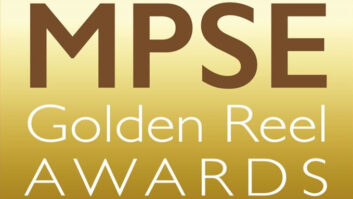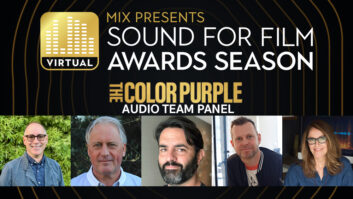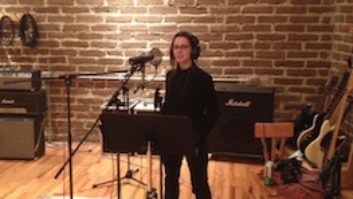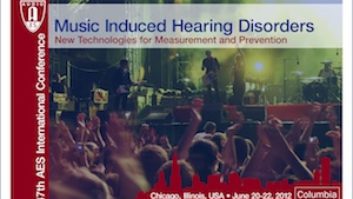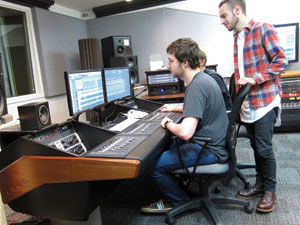
Students in Control B, the in-the-box studio with faders and a quality analog front end.
Photo: Benj Kanters
Colleges, especially long-established ones, tend to develop their own cultures. For Columbia College, founded as and Oratory School in 1890 and today a four-year liberal arts institution, that culture runs deep and is rooted in Chicago itself. Downtown. The Loop. The El and the energy. The arts, the music, the food, the performances. A city very much alive and vibrant, with an arts and media college right in the heart of it. If you’ve ever been on Michigan Avenue, you can almost picture the sidewalks.
Within Columbia College, within the School of Media Arts, is the equally vibrant and active department of Audio Arts & Acoustics, which over the past few years has refined its core curriculum by incorporating hearing physiology, psychoacoustics and more acoustics; created cross-disciplinary links to the Music, Business & Entrepreneurship, Cinema Art + Science, TV, theater and game programs within the college; and established three distinct degrees—B.A. in Audio Design & Production, B.A. in Live and Installed Sound, and a B.S. in Acoustics.
“One of the essences of Audio Arts & Acoustics, one that we are really proud of, is that we’ve created a department that addresses the widest range of opportunities for people interested in studying sound, music, acoustics and hearing,” says Benj Kanters, associate chairman of the department and a professor there since 1993, this following graduation from Northwestern in Radio and TV, a live sound/club career (Amazing Grace) in the ’70s, and a studio owner/engineer career (Studio Media in Evanston, still open, with three rooms) in the ’80s. In the early ’90s, looking for a life with more normal family hours, he went to part-time engineering and began teaching at Columbia. He went back and got his master’s at Northwestern, and for the past decade has focused on hearing education and research.
“We all credit Doug Jones and Howard Sandroff for really envisioning the department as it is today,” he continues. “Doug was the one who brought me here, and he was chairman until 2009. We had acoustics courses back then. We had sound system design courses—even back in the early 1990s we were looking at this very broad range of opportunities. Then Pantelis has come in and taken that concept to a whole new level.”
When Dr. Pantelis Vassilakis, chairman of the department since 2009, came over from nearby DePaul in 2007 to teach part-time, he found, he says, “a macrocosm of what I’ve done all my life. I saw a collection of individuals who are all passionate about sound, and they have deep expertise in all the areas I’ve dabbled in all my professional life, whether it’s studio recording or sound system design, live sound, research in hearing, timbre and perception, sound for picture. All of them in one department! To me it was Disneyland!”
Vassilakis is one of those rare individuals who lives very comfortably in a fluid left-brain/right-brain world. He studied electrical engineering in Greece, got a B.A. in Music Composition and Technology from Kingston University in England, and M.A. and Ph.D. degrees in Ethnomusicology from UCLA, with emphasis on perception, acoustics and aesthetics, as well as a post-doc certificate in Auditory Science.
“No matter what sound is—the sound of an 8-track cassette or the sound of a Harley Davidson—no matter what I am trying to control, I have to understand sound as a physical entity,” he says. “That’s acoustics, a very broad field, based on physics and math. Then I need to understand how the ear works, the last filter before sound goes to the brain. Finally, I have to understand how the two interact to give rise to sound perception, i.e., psychoacoustics. I, the student, now have the key ingredients to systematically control how sounds sound.”
“We have a few core principles, and one of them is that audio is science,” adds Kanters. “Audio is also hearing and perception. And all are supported by math. Those are three key food groups in an audio education. And they make up a core of four courses every student takes in audio theory and hearing. Then there is a four-course production sequence that is tools, techniques and aesthetic-based. Those two cores run in parallel, so as they progress through the program, they have a steady diet of theory and practice.”
Still, it’s not all science and math. The “practice” takes place in the API Legacy/ATC monitor-equipped Control A, where traditions and foundations are emphasized; and Control B, converted to an all-in-the box studio, with fader control and a sweet collection of front-end gear, including two pairs of UA pre’s, a Hardy M1, some Focusrite and GML, an API Lunchbox and Distressors and 1176s. “We invested in solid analog gear that will never grow old,” Kanters says. “Then once you’re in the interface, you’re in the digital world.”
From that core curriculum and core facility, students then pick Audio Design & Production, Live and Installed Sound, or Acoustics as a major, with required side trips into the Music and Business & Entrepreneurship departments, and highly encouraged forays into cross-disciplinary coursework in cinema sound, TV, interactive/game sound and theater—all the benefits of studying sound in a culturally rich, inner-city arts and media college.
“The competition to be a recording engineer is incredibly stiff ,” Kanters concludes. “But if you love audio, there are a lot of wonderful options out there.”
